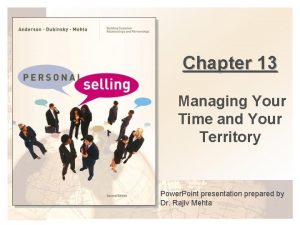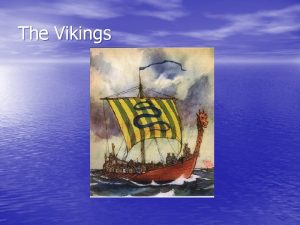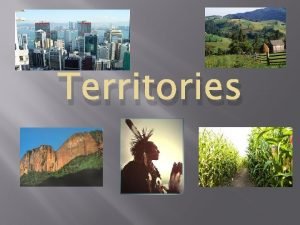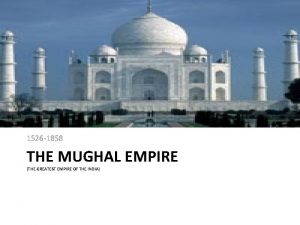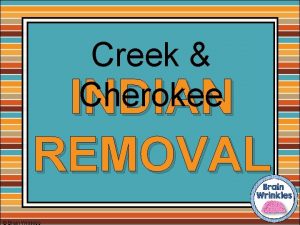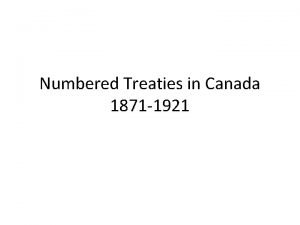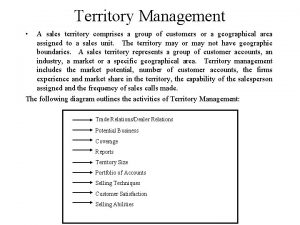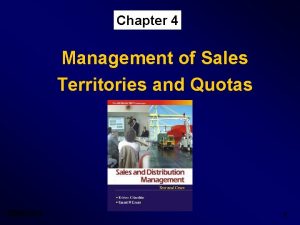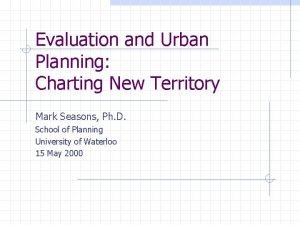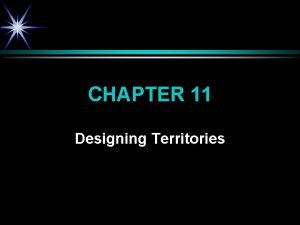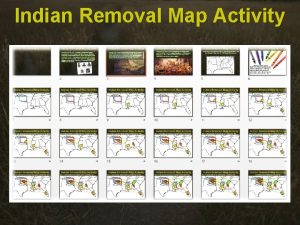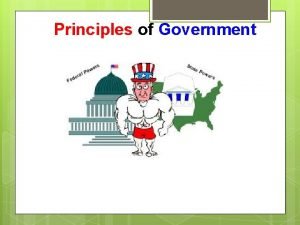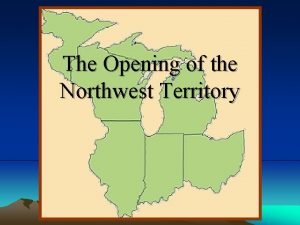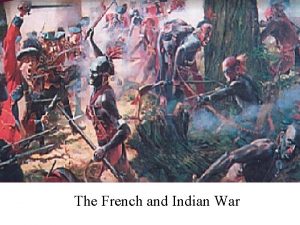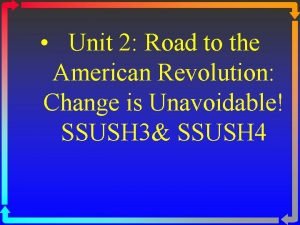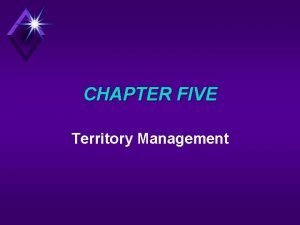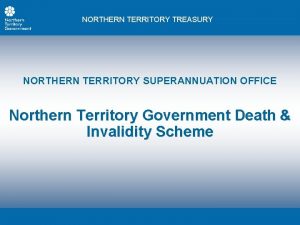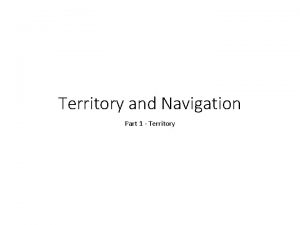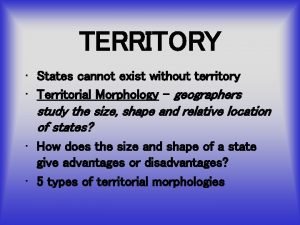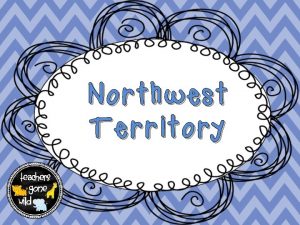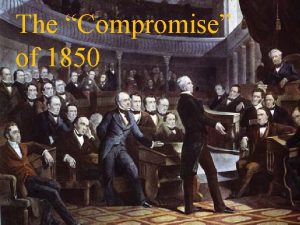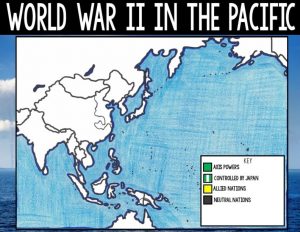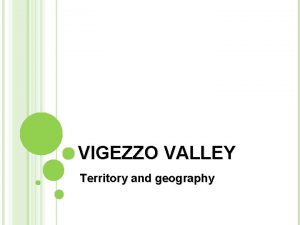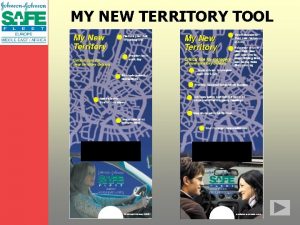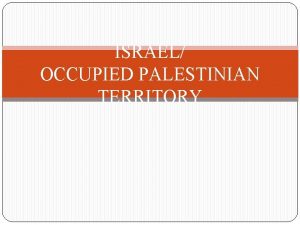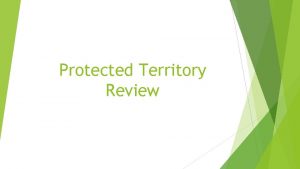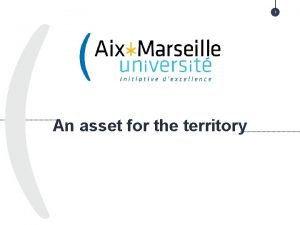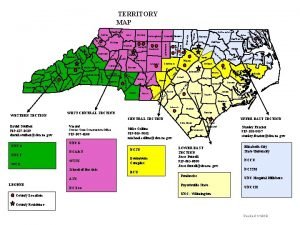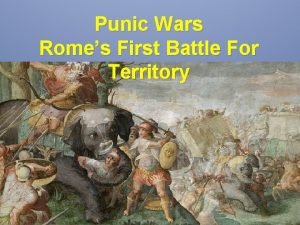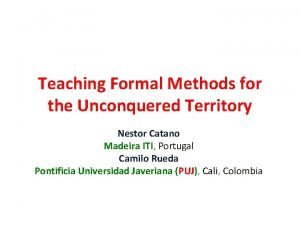What is a Territory A territory is A























- Slides: 23

What is a Territory?

A territory is: �A space where individuals develop relationships with others and their surroundings. �INHABITED �SHARED �ORGANIZED �TRANSFORMED �ISSUES AND SOLUTIONS �Remember that a space becomes a territory when people begin living/working there.

�The image above is Mount Royal park in Montreal. �This is an example of a territory that is shared , inhabited, organized, transformed, and has a variety of different issues. �The park was designed in the 1870’s by F. L. Olmsted. �Olmsted is famous for designing New York Central park. �Mount Royal park was inaugurated in 1876.

An Inhabited and Shared Space �An inhabited territory has two parts. 1. People 2. All services and activities people need to survive. � In a territory, people of diverse backgrounds share a common space. � Different cultures, religions, and nationalities have an influence on life in a certain territory.

�Most territories are divided into zones. �Zones: part of a territory designated by authorities for a specific activity. Ex: Farming is located in agricultural zones. Factories are in industrial zones People live in residential zones.

Organized space �All territories must be organized in a specific way for people to live comfortably. �All territories will have the following: 1. Public services (schools, hospitals, etc) 2. Administration (laws and rules) 3. Areas reserved for specific purposes (zones) 4. Transportation 5. Public venues (city hall, courthouse, etc)

Transformed Space �Territories are constantly changing. New structures are built and old ones torn down. �Certain events may lead to transformation (war, fire, earthquake) �Montreal like other major cities have left traces of the “old” city. �See page 6 of your textbook for an example of this.

Landscapes �Every territory has a landscape. �A landscape is part of a territory which is perceived (seen and understood) by an observer. �A landscape could be a natural setting. Ex: mountains, sunset, lake, etc. �A landscape could also be manmade. Ex: bridges, buildings, monuments, etc.

Common Issues �Everyone who lives in a territory has a specific role. �Depending on their role, every person will have a different interest and opinion on how the territory is used. �For example: a factory owner would like more space given to the industrial sector. �These opposing points of view are what create some of the most common issues.

1. Protecting farmland against growing cities. 2. Transportation. Should areas increase public transport or work to reduce traffic. 3. Finding affordable housing. 4. Preserving natural areas and parks. 5. Controlling tourism. 6. Ensuring long-term development of forest resources. 7. Sharing land with native groups. 8. Preserving the environment.

�Behind each one of these issues there is one or more groups involved. �It is because of all these groups that making a decision in some areas takes a very long time. �Officials need to carefully weigh the situation a develop a solution that will appease all parties. �Officials must understand that any issue in one territory will effect other territories around it.

Types of Territories �All territories are not organized in the same way. �Industrial territories are not will not look the same as agricultural territories. �One could tell immediately what type of territory an area is just by the way it is organized. �For example: Agricultural territories will have much open space in order to grow crops.

�Traditionally territories are divided into five categories. 1. Regional territories: usually one main economic activity (forestry). Ex: Springfield (Simpsons) 2. Urban territory: large city with a large population. Ex: Montreal 3. Native territory: area of land owned and controlled by a native group. Ex: Nunavut 4. Agricultural territory: farmland 5. Protected territory: national park or nature preserve.

What’s in a name? �Territories could be named after; 1. A natural site, ex: Lachine 2. An important historical figure, ex: Joliette 3. Religious figure, ex: San Francisco 4. Aboriginal figure or name, ex: Kanawake

Living Together �Despite obvious differences between cultural groups we are all connected. �Events or decisions in one territory will affect others around the world. �Consider the following examples: 1. Food we eat comes form all over the world. 2. Farm production depends on the global demand.

3) Different cultural groups may share the same space due to immigration. 4) Stores, restaurants, and corporations may belong to a chain, which has locations all over the world. 5) Water pollution in one area may be due to industrial production in another part of the world. 6) We are connected through the internet.

Equality �Although we are all connected, we are not all equal. �Many countries are poor and underdeveloped �Many territories are polluting and destroying the environment. �People all over the world have created organizations to help solve some issues that effect all of us.

Maps �Maps represent territories. They help people find their way or find a location. �They also help people understand the organization of a territory and the events that have shaped it. �To be able to understand maps you must be able to read: the scale, legend, and symbols. �Maps could be printed or digital.

�There are several types of maps one could use. 1) Planisphere: representation of the globe on a flat surface

2) Thematic map: displays a certain characteristic of a region

3) Road maps: shows the locations of cities and towns and the roads that connect them.

4) Historical maps: represents a territory at a certain moment in time.

5) Topographic map: represents physical features of a territory.
 Cloverleaf routing plan
Cloverleaf routing plan Territory management best practices
Territory management best practices Importance of nonverbal communication
Importance of nonverbal communication Where did the vikings live
Where did the vikings live Aurangzeb territory
Aurangzeb territory Rural territory
Rural territory Alexander the great territory
Alexander the great territory Previous owner of british cession
Previous owner of british cession Aurangzeb territory
Aurangzeb territory Brain wrinkles
Brain wrinkles Treaty 1
Treaty 1 Territory management definition
Territory management definition 1200
1200 Establishing sales territories
Establishing sales territories Who lost territory after ww1
Who lost territory after ww1 Charting new territory
Charting new territory Moyamoya mra
Moyamoya mra Writing territories examples
Writing territories examples Indian removal act map activity
Indian removal act map activity A political community in a precise territory
A political community in a precise territory Northwest territory
Northwest territory Map of north america 1754
Map of north america 1754 A political community that occupies a definite territory
A political community that occupies a definite territory Ohio valley territory
Ohio valley territory
